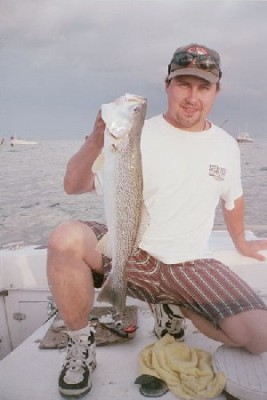
In the Mid Atlantic region, gray trout, also known as weakfish or seatrout, were once one of the most sought after saltwater fish.
Gray trout populations have fluctuated historically in areas such as the Chesapeake Bay, Delaware Bay, and coastal estuaries. Although saltwater trout populations have been down in recent years, fishing for the species in the Mid Atlantic states could rebound eventually.
Gray trout are caught using a variety of methods including fishing with live bait, cut bait, casting artificial lures, trolling, and fly fishing.
In New Jersey the species is known as weakfish or weakie. Bloodworms are a popular bait in some locations. Much of the fishing for weakfish is around inlet jetties or other areas where fishermen find structure, strong currents, and eddies. Weakfish are also taken by Garden State surf fishermen using a variety of baits.
In the Chesapeake and Delaware Bays, a popular technique is to anchor along a channel edge and bottom fish with cut baits. The traditional bait for catching gray trout and speckled trout in the Chesapeake Bay is fresh cut peeler crab or soft crab. Other popular baits include squid, cut spot, live spot, and even chicken breast soaked in peeler crab oil.
In some locations, anglers favor channel edges, anchoring their boats so that the boat lies near the drop off. Often the best fishing occurs during the last 2 hours of the incoming current and the first 2 hours of the outgoing. If a favorable tide coincides with dusk, the fishing has an ever better chance of being good.
In the middle and lower Chesapeake Bay, anglers encounter gray trout in the spring and fall in very shallow water. Gray trout are caught near Parker, Watts, Tangier, Smith, South Marsh, and Fox Islands.
Shallow water fishing for trout can be very exciting as the fish are usually caught together with speckled trout, croaker, striped bass, bluefish, flounder, and drum. In the same areas, saltwater fly fishermen also catch trout. Shallow water fishing in the Chesapeake Bay is often best from sunset to midnight.
Gray trout are also caught by casting bucktails or other lures near rockpiles, jetties, boat wrecks, and other structure. One popular choice for casting is a white bucktail with a plastic worm and a piece of peeler crab.
Anglers also catch gray trout while trolling with wire line. Catches of trout are sometimes incidental although gray trout are targeted specifically with wire line at times. This is especially true along the Chesapeake Bay Bridge Tunnel (CBBT) where anglers catch gray trout by trolling bucktails very slowly along pilings and bridge tunnels.
Another trout fishery in Virginia occurs along the high rise bridge area of the Chesapeake Bay Bridge Tunnel. In May thru July, small trout are sometimes common near the high rise bridge, in depths of 40 to 70 feet of more. They are easily caught by drifting strips of squid.
The combination of extreme depth and current requires the use of braided line in order to feel the fish. When gray trout arrive in the area, they are sometimes accompanied by flounder, croaker, kingfish, and other species.